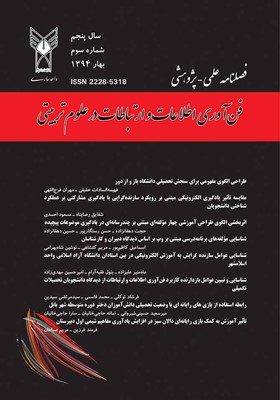شناسایی مؤلفههای برنامهدرسی مبتنی بر وب بر اساس دیدگاه دبیران و کارشناسان
محورهای موضوعی : آموزش عالی
اسماعیل کاظم پور
1
*
![]() ,
مریم گلشاهی
2
,
نوشین شاه بهرامی
3
,
مریم گلشاهی
2
,
نوشین شاه بهرامی
3
1 - استادیار گروه علوم تربیتی، دانشگاه آزاد اسلامی واحد تنکابن، تنکابن، ایران
2 - دانشآموخته کارشناسی ارشد برنامهریزی آموزشی، دانشگاه آزاد اسلامی واحد تنکابن، تنکابن، ایران
3 - دانشجوی دکتری برنامهریزی درسی، دانشگاه آزاد اسلامی واحد تنکابن، تنکابن، ایران
کلید واژه: الگو, دبیران, مؤلفههای برنامهدرسی, وب, کارشناسان,
چکیده مقاله :
هدف از این پژوهش، ارایه الگویی برای تدوین برنامهدرسی مبتنی بر وب است. این تحقیق، به صورت توصیفیـ تحلیلی بوده و با عنایت به پرسشهای تحقیق از نوع کاربردی است. جامعه آماری، شامل 524 نفر از دبیران هنرستانهای فنیـ حرفهای و 58 نفر از کارشناسان علومتربیتی شهرستان لاهیجان در سال 1393 بود که از این تعداد 308 نفر از دبیران و 58 نفر از کارشناسان به عنوان نمونه آماری انتخاب شدند. ابزار گردآوری دادهها، پرسشنامه محققساخته متشکل از 72 سؤال برنامهدرسی مبتنی بر وب است. برای بررسی روایی سازه پرسشنامه، از برآورد کفایت نمونهبرداری (KMO) و آزمون کرویت بارتلت که حکایت از وجود شرایط مناسب اجرای تحلیل عاملی دارند، استفاده شد. پایایی پرسشنامه با استفاده از ضریب آلفای کرونباخ 94/0 برآورد شد. برای تحلیل دادهها از آمار توصیفی و استنباطی شامل آزمون تحلیل عاملی استفاده شد. تحلیل عاملی بر پایه روش تحلیل مؤلفههای اصلی، انجام گرفت و نتایج نشان داد، برنامه درسی مبتنی بر وب، شش مؤلفه اساسی دارد و قابل مدلسازی است. این تعداد مؤلفهها روی هم 280/51 درصد کل واریانس متغیرها را تبیین میکنند. در مرحله نهایی با استفاده از چرخش Olbimin ماتریس عاملی ساختار ساده عاملها بهدست آمد. عاملها تحت عناوین اهداف و نیازها، محتوا و منابع، شیوههای یاددهی- یادگیری، اجرا و ارزشیابی نامگذاری شدند. در نهایت با توجه به این شش عامل مؤثر بر برنامهدرسی مبتنی بر وب، مدل مفهومی آن طراحی شد.
The purpose of the present study was to produce a web-based curriculum model. This study was an applied descriptive-analytic survey. The statistical population of the study consisted of 524 individual teachers and 58 pedagogical experts from Lahijan, Iran in 2014, among whom 308 teachers and 58 pedagogical experts were selected as the sample size. The researcher-made questionnaire including 72 items on web-based curriculum was used as the data gathering tool. The validity of the questionnaire was estimated by the Kaiser-Meyer-Olkin (KMO) measure of sample adequacy and Bartlett test of sphericity which proved an adequacy for conducting the factorial analysis and reliability of the questionnaire was estimated by Cronbach Coefficient (α=0.946). To analyze the data, the descriptive statistics and inferential statistics with factorial analysis test were used. The factor analysis was conducted based on the analysis of the main components, and the results revealed that the web-based curriculum model comprised of 6 main components which could be modeled. The main components, totally, explained the 51.280% of the variables total variance. Finally, simple structure of factors was obtained by using the oblimin rotation of factorial matrix. The factors were termed as 'objectives and needs', 'content and sources', 'learning-teaching methods', 'implication' and 'evaluation'. Finally, based on these factors, a conceptual model for web-based educational programs was designed.

